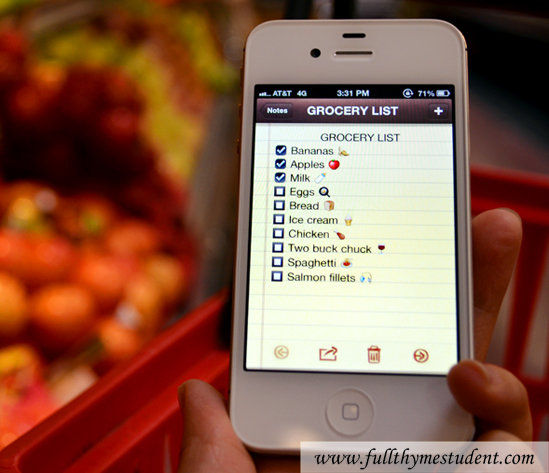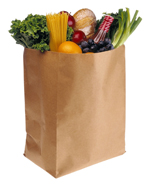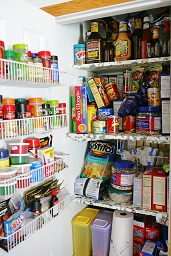15 Tips on How to do Grocery Shopping on a Budget

We’ve all been there: you want to cook something and you have zero ingredients to work with. Or, say it’s 7PM and you’re starving, so you open your pantry or fridge and there’s NOTHING. Didn’t you just go grocery shopping? Where’s all the food to cook with? The only options you have are to eat stale cereal, order take-out, or go for the junk food.
I’ve been there. I know how difficult it is to keep a food budget as a college student. It sucks. It’s literally the most frightening thing when you leave a grocery store and all you bought were frozen pizzas, Top Ramen noodles, chips,  cookies, Eggo waffles, and maybe a few apples. Obviously, poor quality food is cheaper than fresh food, but we all know that processed foods don’t make a sustainable diet. Click here for a basic grocery shopping list to use during your next trip to the store.
cookies, Eggo waffles, and maybe a few apples. Obviously, poor quality food is cheaper than fresh food, but we all know that processed foods don’t make a sustainable diet. Click here for a basic grocery shopping list to use during your next trip to the store.
Here’s the thing! Grocery shopping doesn’t have to be so difficult, and you can definitely eat healthfully throughout college and not feel limited by Top Ramen, spaghetti, or pop tarts. I will admit that grocery shopping was incredibly difficult when I first started living on my own. I was unsure how quickly food went bad, how much my budget should be, and what I would eat the next morning for breakfast. My mom even offered to have food shipped to my college apartment because she was worried I didn’t know how to take care of myself. (Thanks, Mom) It took a few months of practice, but I think I’ve nailed the art of grocery shopping.
Everybody’s budget will vary because overall, it depends on your location, the quality of food you purchase, how much you eat, and so forth. To put things into perspective, I went to college in Los Angeles, and local quality produce wasn’t cheap. The stores I had were Ralph’s, Trader  Joe’s, and Whole Foods. I averaged about $125 to $150 per month in groceries, and I went grocery shopping about 3 to 4 times per month. If you’re working on a college budget, spending beyond $200 per month would be quite extravagant. You can definitely aim to spend $25-$35 per week as an individual college student for just regular healthy food and ingredients. Of course, if you have to purchase toiletries, cleaning supplies, staple items for the kitchen (i.e., olive oil, balsamic vinegar, etc.), or other miscellaneous junk for the apartment, that doesn’t count. So, plan to budget for those items separately every once in a while. Click here for a list of staple pantry items you can always consult if you need help.
Joe’s, and Whole Foods. I averaged about $125 to $150 per month in groceries, and I went grocery shopping about 3 to 4 times per month. If you’re working on a college budget, spending beyond $200 per month would be quite extravagant. You can definitely aim to spend $25-$35 per week as an individual college student for just regular healthy food and ingredients. Of course, if you have to purchase toiletries, cleaning supplies, staple items for the kitchen (i.e., olive oil, balsamic vinegar, etc.), or other miscellaneous junk for the apartment, that doesn’t count. So, plan to budget for those items separately every once in a while. Click here for a list of staple pantry items you can always consult if you need help.
I have created a list of 15 grocery shopping tips that I know will help you. You don’t have to be a broke college student for these tips to work for you. I promise you this: I went grocery shopping only about 3-4 times per month in college because I was always so well-stocked with healthy food in my kitchen that I never worried about starving or having no ingredients to cook with. If you have grocery shopping tips that work for you, please feel free to share a comment below!
1. Set a budget before you go to the grocery store
Decide how much you’re willing to spend before you step out of the house. This makes all the  difference in smart grocery shopping. Only you know how much you have to spend, so decide now how much you want to spend each month. $100? $150? $200? Be reasonable and smart and know your limits. If you want to spend $25 per grocery shopping trip, then leave that debit or credit card at home and take $25 in cash with you to the grocery store. That way, you will never go over budget.
difference in smart grocery shopping. Only you know how much you have to spend, so decide now how much you want to spend each month. $100? $150? $200? Be reasonable and smart and know your limits. If you want to spend $25 per grocery shopping trip, then leave that debit or credit card at home and take $25 in cash with you to the grocery store. That way, you will never go over budget.
2. Make a shopping list before you go to the grocery store and STICK TO IT
If you plan on getting ten packages of Oreos and 60 frozen pizzas at the grocery store, I still want you to write that on a list before you head out to the store. At least they’d be planned purchases rather than compulsive purchases. (And maybe, just maybe.. hopefully.. you’ll realize that that’s not the diet you want to maintain). How many pounds of apples are you going to get? How many bags of chips? Packages of spaghetti? Write it all down. Nowadays, I use my smartphone. Make a list and check it off as you go through the grocery store.
3. Try not to go to the grocery store while hungry
Yes, I know it happens. You’re at the grocery store because you’re out of food, so of course you’ll be hungry. But I’m telling you. Don’t be tempted to buy that pre-made sandwich or bag of chocolate-covered pretzels because you’re hungry at that very moment. You’ll undoubtedly give into temptation and definitely go over budget.
4. Ignore the snacks at the check-out counter
 Don’t do it. Just look away. Trader Joe’s, I love you, but you really gotta stop selling me snacks for $1.69. You always put all your deliciousness right there when I’m checking out, and you just made me add another $10 to my grocery bill! So, lesson of the day: ignore the snacks.
Don’t do it. Just look away. Trader Joe’s, I love you, but you really gotta stop selling me snacks for $1.69. You always put all your deliciousness right there when I’m checking out, and you just made me add another $10 to my grocery bill! So, lesson of the day: ignore the snacks.
5. Don’t buy the specials you didn’t plan on purchasing in the first place
You’re walking through the aisles and you see a big sign that says “Buy 2, Get 1 half off!” Or, my favorite, “Buy 1, get 1 free!” Look — they’re not really specials. Sadly, they’re effective marketing schemes that try to make you buy crap you wouldn’t have bought had it not been on “sale.” Here’s my take on promotions like that. You know during Christmas sales at the mall when they say you’ll save 80%-off your purchases? My dad says you’ll always save 100% if you just sit your butt at home and don’t shop at all. Smart man. Overall lesson: just because it’s 30-, 40-, or 50%-off does not mean you have to buy it. Cut out the impulsive shopping.
buy crap you wouldn’t have bought had it not been on “sale.” Here’s my take on promotions like that. You know during Christmas sales at the mall when they say you’ll save 80%-off your purchases? My dad says you’ll always save 100% if you just sit your butt at home and don’t shop at all. Smart man. Overall lesson: just because it’s 30-, 40-, or 50%-off does not mean you have to buy it. Cut out the impulsive shopping.
6. Save your receipts and track your expenditures
 There are many reasons to keep a receipt. I can’t tell you how many times I’ve accidentally bought moldy bread products and had to return it. Many stores don’t require a receipt these days for returns or exchanges on a bad product, but keep your receipt just in case. Your receipts will also allow you to keep track of how much you spend on food so you can begin to set a budget and learn your limits. Oh, and what’s with all these super long receipts these days? I buy one thing at CVS and I get a receipt that measures 3 feet long with about 50 coupons on it. That’s cool. Check out those coupons and see if any float your boat.
There are many reasons to keep a receipt. I can’t tell you how many times I’ve accidentally bought moldy bread products and had to return it. Many stores don’t require a receipt these days for returns or exchanges on a bad product, but keep your receipt just in case. Your receipts will also allow you to keep track of how much you spend on food so you can begin to set a budget and learn your limits. Oh, and what’s with all these super long receipts these days? I buy one thing at CVS and I get a receipt that measures 3 feet long with about 50 coupons on it. That’s cool. Check out those coupons and see if any float your boat.
7. Make sure prices are accurate at the check-out counter
 Oftentimes, grocery stores can mis-price items when you check-out and the item you thought was $2 is actually $5. That makes a big difference, and you should never hesitate to ask the checker to double check the price of any item. Keep a close eye on that screen as they ring up all your groceries.
Oftentimes, grocery stores can mis-price items when you check-out and the item you thought was $2 is actually $5. That makes a big difference, and you should never hesitate to ask the checker to double check the price of any item. Keep a close eye on that screen as they ring up all your groceries.
8. Clip coupons if you have time; otherwise, skip it
I admit I was just too busy in college to clip coupons. Look, I’ve seen the specials on “Inside Edition” about the ladies who spend a total of $0.03 on 2 carts full  of groceries. It’s insane and kinda cool in a twisted way. Couponing can be very effective, but let’s be real: it’s completely time consuming.
of groceries. It’s insane and kinda cool in a twisted way. Couponing can be very effective, but let’s be real: it’s completely time consuming. Thyme Time is money, and no student has time to clip coupons. So, skip it if you are too busy and move on. Now, if you have time, it’s not a bad idea to browse through your grocery store’s weekly ad for specials on items you were planning on getting anyway. It’s all in the plan of attack.
9. Buy essential food items in bulk
By essential, I mean things on my list of essential pantry items, such as pastas, cornmeal,  oatmeal, sugar, olive oil, etc. You know, things you cook with…dry foods that don’t go bad too quickly. Don’t make a habit of loading up on too many fresh ingredients; you don’t have to buy 5 bunches of Romaine just because they were on sale. I’ll warn you now — more often than not, your food will go bad, and you’ll end up throwing it all away. The money you thought you saved results in wasted food. In general, buy only the amount you need at any given time, and don’t try to stockpile on fresh ingredients. However, if you have awesome roommates, it’s always a great idea to divide and share bulk items with your roommates to reduce costs.
oatmeal, sugar, olive oil, etc. You know, things you cook with…dry foods that don’t go bad too quickly. Don’t make a habit of loading up on too many fresh ingredients; you don’t have to buy 5 bunches of Romaine just because they were on sale. I’ll warn you now — more often than not, your food will go bad, and you’ll end up throwing it all away. The money you thought you saved results in wasted food. In general, buy only the amount you need at any given time, and don’t try to stockpile on fresh ingredients. However, if you have awesome roommates, it’s always a great idea to divide and share bulk items with your roommates to reduce costs.
10. Substitute expensive ingredients with cheaper ones, within reason
Say you found an excellent recipe and it asks you to use 2 tablespoons of heavy cream. Is it really worth it to purchase a pint of heavy cream just for 2 tablespoons? Probably not. Especially if you don’t plan on using the rest of it in any other way. Consider using something else in place of the required ingredients. E.g., if you don’t want to buy fresh herbs, that’s fine! Consider dried herbs. But I do want to make this point: if you end up with bad results, please do not blame somebody for providing a “bad recipe” if you have chosen not to follow a recipe exactly. It’s really unfair to blame the person who wrote the recipe. I see it too often on the ‘net and it’s very annoying.
11. Avoid Fun-size packages, Pre-chopped vegetables/fruits, Pre-seasoned meats, etc.
Don’t buy things in small packages. You know what I mean. Or maybe not, so let me clarify. I’m talkin’ about  snack-size bags of chips, cookies, granola, etc. It’s so much more affordable to buy the family-sized packages and put food in your own tupperware or Ziplock bags. Also, it’s really expensive to buy pre-chopped vegetables such as onions and mushrooms. Trust me. Buy food in their whole form and cut it yourself; it’s so much cheaper and not difficult at all. As for “convenient” pre-seasoned meats, you can save endlessly if you buy fresh fish or meat and marinade it yourself.
snack-size bags of chips, cookies, granola, etc. It’s so much more affordable to buy the family-sized packages and put food in your own tupperware or Ziplock bags. Also, it’s really expensive to buy pre-chopped vegetables such as onions and mushrooms. Trust me. Buy food in their whole form and cut it yourself; it’s so much cheaper and not difficult at all. As for “convenient” pre-seasoned meats, you can save endlessly if you buy fresh fish or meat and marinade it yourself.
12. Don’t limit yourself to only certain brands
I admit there are certain things I would not buy a store-brand version for because my preferred brand is infinitely superior. But try to keep an open mind. If it’s something like sour cream you need and your favorite brand costs $5 and the store brand costs only $2, I’d go for the latter. Come on, it’s sour cream. How about things like dried spices? Pastas? Flours? Brands, for the most part, shouldn’t be a big deal for college students who are just starting out in the kitchen.
13. Eat the seasons. In other words, shop by season
 Most items will be more affordable when they are in season. During the fall, you’ll get quality squashes, cranberries, etc. During the summertime, you’ll find excellent fruits such as apricots, strawberries, nectarines, etc. Don’t know which items are in season right now? Check out Eat the Seasons to see what’s in season now. Or, if you want to see what’s in season for your specific US state, check out this excellent seasonal food guide.
Most items will be more affordable when they are in season. During the fall, you’ll get quality squashes, cranberries, etc. During the summertime, you’ll find excellent fruits such as apricots, strawberries, nectarines, etc. Don’t know which items are in season right now? Check out Eat the Seasons to see what’s in season now. Or, if you want to see what’s in season for your specific US state, check out this excellent seasonal food guide.
14. Always have a well-stocked pantry and refrigerator
Duh, right? No, I mean it. If you have a well-stocked pantry that always has go-to ingredients  such as spices, pastas, rices, beans, etc., you’ll only have to go buy fresh ingredients at the grocery store to make any freaking meal you want. You heard me. Make one big trip at the beginning of the month and buy those bottled and jarred sauces, frozen vegetables, and grains because once you have those essential ingredients, you’ll only need the store for fresh produce. Why do you think your mom can whip up any meal whenever she wants? It’s because she always has her secret weapons in the pantry or fridge, whether it’s canned tomatoes, flour, frozen shrimp, frozen peas…. It’s always there because those are her staples. So, do it. Have a list of staples that you always have to have, and then restock when necessary.
such as spices, pastas, rices, beans, etc., you’ll only have to go buy fresh ingredients at the grocery store to make any freaking meal you want. You heard me. Make one big trip at the beginning of the month and buy those bottled and jarred sauces, frozen vegetables, and grains because once you have those essential ingredients, you’ll only need the store for fresh produce. Why do you think your mom can whip up any meal whenever she wants? It’s because she always has her secret weapons in the pantry or fridge, whether it’s canned tomatoes, flour, frozen shrimp, frozen peas…. It’s always there because those are her staples. So, do it. Have a list of staples that you always have to have, and then restock when necessary.
15. Don’t fret. Practice makes perfect 🙂
 Dang, thanks for reading til the end. I promise grocery shopping will get easier over time. It takes a little effort at first to do it efficiently on a tight budget, but I have faith you can do it. Always remember what George Carlin said: Don’t sweat the petty stuff, and don’t pet the sweaty stuff. You’ll nail the art of grocery shopping in no time!
Dang, thanks for reading til the end. I promise grocery shopping will get easier over time. It takes a little effort at first to do it efficiently on a tight budget, but I have faith you can do it. Always remember what George Carlin said: Don’t sweat the petty stuff, and don’t pet the sweaty stuff. You’ll nail the art of grocery shopping in no time!

Leave a Reply to Time management | Amy Ridings Cancel reply